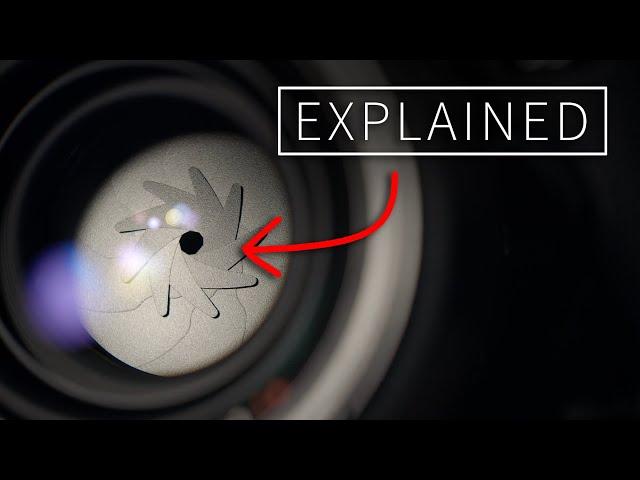
Why F22 Photos Are SOFTER Than F8 - Diffraction Explained!
Комментарии:

Fantastic 10/10
Ответить
This is one of the best practical e plantation I have seen. My rating is 10/10
Ответить
BRILLIANT and understandable video, thanks!
A while back I had a nice lens that performed very well on older 12 and 16 Mp bodies but absolutely SUCKED on my (then) new 22Mp camera sensor from even f/8 onward…

Does the same hold true for film photography? Film uses chemicals but not pixel sensors. The resolution (grain) depends on the ISO/ASA of the specific film speed I suppose. Thank you for the very good explanation.
Ответить
The content on this video was EXACTLY what I was looking for.
I was confused after watching videos from other creators because they showed the point of light superimposed on the photosite grid. It's confusing because I thought the superimposed point of light was the image the photosite gave.
In this video, the points of light start off superimposed over a photosite grid, but then it transitions to show how the photosites are interpreting the data.
After watching this video, I immediately made the connection between what the photosites do and the process of quantization. So, much like with auto-tune in pop songs, the differences in data need to be large enough to be interpreted as a different value.

Thank you so much for this explanation. I have been wondering why my shots are soft focus at higher apertures and your video explains it perfectly so 10 out of 10 for your video!!! Now begs the question how can we take a super high depth of field photo without having to stop down to high apertures resulting in soft focus?
Ответить
10.5/10
Ответить
10 out of 10. Thanks!!
Ответить
how can i change or remove diffraction
Ответить
Deep! Thank you. 📸
Ответить
Excellent. Passed this on to my friend who shoots landscapes at f/22 on a R5.
Ответить
Many thanks to Mr Cheng ! Your explanations will have a score of ten on a scale of maximum ten !😊
Ответить
I can't help but wonder how Ansel Adams and Group f/64 managed to avoid diffraction.. his prints were incredible sharp.
Ответить
In the same zoom lens, the f/number that makes diffraction visible is the same in all focal distance range? Because i thought diffraction as to do with the physical size of the aperture... This means, that for the same F/number the diaphragm has different sizes depending of the focal distance (F=FD/d). So, as we increase the focal distance, the diffraction will begin in higher F numbers. Is this true?
Or the same question for long primes. Is diffraction a problem for a 300mm prime?

Great
Ответить
super helpful and clear explanation! Keep up the great work!
Ответить
10/10. Nice job
Ответить
Good video
Ответить
Ty so much. now I know more about my Panasonic HC X1.
Ответить
wot? is light waves?
Ответить
A good explanation of this phenomenon. Worth pointing out that the effect depends almost solely on aperture not focal length and that the diameter of the Airy disc increases much more rapidly as one stops down the lens. The effect on a digital sensor is also governed as you say by pixel size - the problem really begins when the disk diameter is greater than the area of the pixel - hence film copes somewhat better subject to its resolution limit. It is also worth pointing out that when printing large from a small sensor you increase the lack of resolution due to diffraction as just as you magnify the image you also magnify the Airy disk! This is why photographers using 10x8 cameras were happy to use f45 or f64 because to produce a 20x16 print they were using an area magnification of 4x and the size of the disc remained insignificant. The site Cambridge in Color gives another great explanation plus an active calculator that lets you check the diffraction limit of your lens/camera combination 9/10
Ответить
Malaysian content creator.. WOW
Ответить
Your explanations are always to the point, clear and very helpful. 10/10. Thank you!!
Ответить
The Laowa 24mm Macro Probe Lens is interesting because its aperture starts at f/14 and closes down to f/40 , i wonder where diffraction starts to become noticeable on that crazy looking lens
Ответить
11/10 Excellent. Really clear explanation. Just keep doing what you're doing.
Ответить
9.5/10! 👏🏾👏🏾👏🏾👏🏾 Definitely don’t feel like a moron now when trying to understand cameras more in depth.
Ответить
8
Ответить
10
Ответить
If 10 is perfect, and nobody is perfect in this world i'd give you a 9/10.
Ответить
Excellent! 10
Ответить
Excellent explanation of light diffraction 9/10.
Ответить
Thanks for sharing!
Ответить
10/10, perfect!!
Ответить
Now that I think about it, the first camera that I'm going to buy (not now due to pandemic, it's the Canon T7i) doesn't have autofocus at F8.
how bad would this be for me?

Thank you for explaining that so well, now I know what I have probably been doing wrong and I can work on fixing it. I'd give you 10/10 😁
Ответить
10!
Ответить
Nice. 10/10
Ответить
Dude that was claer
10/10

Taking a little from all those reality shows, you sir............... ............. ............. are safe for another week.
Thanks for sharing again. 👍👍👍👍👍

I appreciate the explanation, but I was bit distracted by your speech pattern. You tend to say "actually" quite often. Nonetheless, 9/10. Cheers! :)
Ответить
Good job! Now how about a video that explains why theoretically the larger the aperture the higher the resolution and why in practice this does not happen (yet)?
Cheers

Whats this guys name, I don't see it posted anywhere, he seems to know his stuff.
Ответить
Shooting at F22 produced very sharp images with slides and film. Why does it do the opposite with digital?
Ответить
Very comprehensive video which clearly explains the diffraction of the lenses, will done! 10/10
Ответить
11/10. Will share.
Ответить
Pretty good explanation.
Ответить
8/10 overall, I enjoyed this, and my only suggestions would be some graphics and visuals. 10/10 for the explanation though. I'm not a subscriber, but I've come across your videos before and they're usually pretty good. Keep it up!
Ответить
and on macro lens ?
Ответить
7/10
Ответить

























